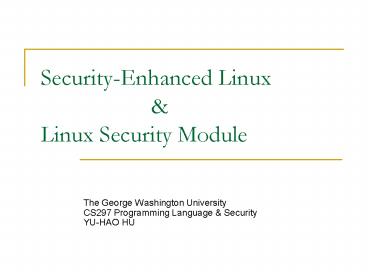Security-Enhanced Linux PowerPoint PPT Presentation
Title: Security-Enhanced Linux
1
Security-Enhanced Linux Linux Security
Module
- The George Washington UniversityCS297
Programming Language SecurityYU-HAO HU
2
Introduction Why SELinux ?
- Discretionary Access Control (DAC) has not enough
choices for controlling object. - Mandatory Access Control (MAC) allows you to
define permissions for how all processes (called
subjects) interact with other parts of the system
such as files, devices, sockets, ports, and other
processes (called objects in SELinux).
3
Linux Security Module Overview
- SELinux motivated the creation of LSM.
- Separate kernel from security features in order
to minimize the impact to kernel. - LSM doesnt provide any security rather it add
security fields to kernel and provide interface
to manage these fields for maintaining security
attributes..
4
Linux Security Module Hooks
- Hooks are a set of functions to control
operations on kernel objects and security fields
in kernel data structures. - Management Hooksused to manage security
fields.Ex. file_alloc_security - Control Hooksused to perform access
controlsEx. selinux_inode_permission
5
LSM Hook Architecture
6
SELinux Overview
- Implement Flask architecture.
- SELinux is implemented in the Linux kernel using
the LSM (Linux Security Modules) framework. - To support fine-grained access control, SELinux
implements two technologies Type Enforcement
(TE) and Role-based Access Control (RBAC).
7
Flask Architecture WHO is doing WHAT
8
Type Enforcement Domain Transition
- DomainDomain defines what process can do.
- TypeA type is assigned to an object and
determines who gets to access that object. - Domain Transitionwhen a process invoke another
process - Type Enforcementwhen a object is accessed
9
Role-Based Access Control
- Associate the role with domains that a user role
can access. - If a role is not authorized to enter a domain,
then it will be denied.
10
References
- Linux Security Module Framework. 2002 Ottawa
Linux Symposium, Ottawa, Canada, June 2002. - Linux Security Modules General Security Support
for the Linux Kernel. 11th USENIX Security
Symposium, San Francisco, CA, August 2002. - Red Hat SELinux Guide
- Configuring the SELinux PolicyStephen Smalley
(NAI Labs) - Implementing SELinux as a Linux Security
ModuleStephen Smalley, Chris Vance, and Wayne
Salamon (NAI Labs) - Getting Started with SE Linux HOWTO the new SE
Linux Faye Coker - Writing SE Linux Policy HOWTO Faye Coker

